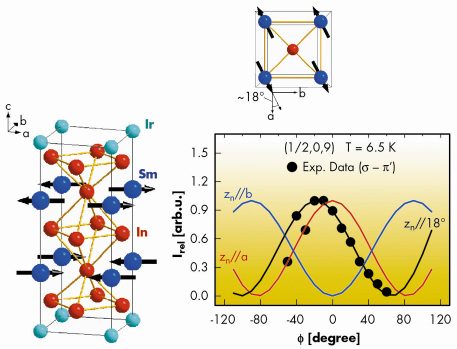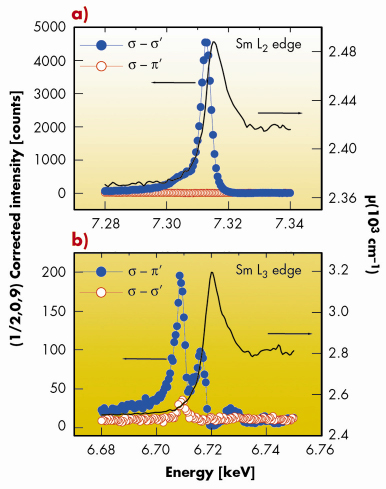- Home
- Users & Science
- Scientific Documentation
- ESRF Highlights
- ESRF Highlights 2007
- X-ray Absorption and Magnetic Scattering
- Probing 4f magnetism of intermetallic compounds by resonant magnetic scattering
Probing 4f magnetism of intermetallic compounds by resonant magnetic scattering
Recently, a new series of tetragonal compounds, RmMIn3m+2 (R= light rare-earth; M=Rh or Ir; m=1,2), have become an interesting area of research since the discovery of new heavy fermion superconductors (HFS) for some of the Ce-based compounds [1]. Extensive investigation on these materials has revealed fascinating physical properties such as quantum criticality, non-Fermi-liquid behaviour, and interplay between magnetism and superconductivity, as the Ce-based compounds in these series are presumably magnetic-mediated HFS.
The existence of structurally-related families of rare-earth-based compounds provides a great opportunity to explore the involvement of the 4f-electron magnetism in HFS. From earlier studies, the role was established for the tetragonal crystalline electrical field (CEF) in determining the spatial direction of the ordered R moments with respect to the lattice and the evolution of the Néel temperature TN in the series. The compounds of this family containing Sm ions remain untested and may be particularly important because of the presence of excited J-multiplet states in Sm3+ and quadrupolar interactions. Sm2IrIn8 in particular is the only compound with a clear first order antiferromagnetic transition at TN = 14.2 K. This value is slightly smaller than the TN~16 K of the cubic SmIn3 which according to the CEF trends observed in other members of this family suggest that the ordered Sm moments should lie in the ab plane.
We report the solution of the magnetic structure of the intermetallic antiferromagnet Sm2IrIn8 by means of X-ray resonant magnetic scattering (XRMS) which is the only technique available for the investigation of microscopic magnetism for highly neutron absorber ions such as Sm, where the often preferred technique of neutron scattering becomes nearly prohibitive.
XRMS studies were performed at beamline 4-ID-D at the Advanced Photon Source (APS) in the vertical scattering geometry and at beamline ID20 at the ESRF in the horizontal configuration. This allowed us to access all four polarisation channels of the 2x2 matrix of the electric dipole transition form factor and to determine the magnetic moment orientations through their polarisation dependence at the dipolar (E1) resonance by comparing the relative intensities of experimental (1/2,0,l) magnetic peaks with the calculated ones.
To determine the exact orientation of the magnetic moments within the ab plane, we have performed azimuthal scans (![]() scan) through the (1/2,0,9) reflection (Figure 116) at the E1 resonance. At the
scan) through the (1/2,0,9) reflection (Figure 116) at the E1 resonance. At the ![]() -
-![]() ’ polarisation channel, this procedure allows the determination of moment directions with no ambiguity because the magnetic cross section is strongly dependent on the magnetic moment direction and the polarisation of the incoming and scattered radiation. Figure 116 shows a model of the magnetic unit cell of Sm2IrIn8 can be constructed using these results.
’ polarisation channel, this procedure allows the determination of moment directions with no ambiguity because the magnetic cross section is strongly dependent on the magnetic moment direction and the polarisation of the incoming and scattered radiation. Figure 116 shows a model of the magnetic unit cell of Sm2IrIn8 can be constructed using these results.
 |
|
Fig. 116: Magnetic structure of Sm2IrIn8 below TN=14.2 K (left) and a Sm-In plane top view (top right) showing the in-plane arrangement of Sm moments. The graphic (bottom right) shows the relative intensities as a function of the azimuthal angle to the (1/2 0 9) magnetic reflection. The other curves represent the variation expected for the magnetic moments along the a (red line), b (blue line), and 18° away from a (black line), directions. |
The energy line shape curves for the polarisation channels ![]() -
-![]() ’ and
’ and ![]() -
-![]() ’ of the (1/2,0,9) diffraction peak at (a) the L2 and (b) the L3 absorption edges of Sm3+ ion at T=5.9 K are shown in Figure 117. The solid lines in both panels represent the absorption spectrum, µ(E), extracted from fluorescence yield. Our data in Figure 117a reveal a strong enhancement of the scattered intensities at the
’ of the (1/2,0,9) diffraction peak at (a) the L2 and (b) the L3 absorption edges of Sm3+ ion at T=5.9 K are shown in Figure 117. The solid lines in both panels represent the absorption spectrum, µ(E), extracted from fluorescence yield. Our data in Figure 117a reveal a strong enhancement of the scattered intensities at the ![]() -
-![]() ’ channel (closed circles) and no enhancement at the
’ channel (closed circles) and no enhancement at the ![]() -
-![]() ’channel for the same energy range. The energy line shape around the Sm L3 edge is presented in Figure 117b. A high energy peak appears at 6.716 keV, while a low energy and more intense enhancement can be observed at 6.708 keV. The presence of this pre-edge enhancement in the energy curves of Figure 117 confirms an expected quadrupole (E2) contribution to the resonant X-ray scattering in Sm2IrIn8.
’channel for the same energy range. The energy line shape around the Sm L3 edge is presented in Figure 117b. A high energy peak appears at 6.716 keV, while a low energy and more intense enhancement can be observed at 6.708 keV. The presence of this pre-edge enhancement in the energy curves of Figure 117 confirms an expected quadrupole (E2) contribution to the resonant X-ray scattering in Sm2IrIn8.
 |
|
Fig. 117: Energy scan of the (1/2,0,9) magnetic peak at T = 5.9 K for |
Following the investigation of the isostructural magnetic non-Kondo compounds from the R2MIn3m+2 family, we have studied the magnetic structure of Sm2IrIn8. The magnetic order is commensurate with propagation vector ![]() = (1/2,0,0) and the Sm moments oriented in the ab plane, 18° away from the a axis. Based on this result we conclude that the general CEF trend of the RmMIn3m+2 is also qualitatively present in Sm2IrIn8.
= (1/2,0,0) and the Sm moments oriented in the ab plane, 18° away from the a axis. Based on this result we conclude that the general CEF trend of the RmMIn3m+2 is also qualitatively present in Sm2IrIn8.
References
[1] J.D. Thompson et al., J. Magn. Magn. Mater. 226-230, 5 (2001).
[2] P.G. Pagliuso et al., J. Appl. Phys. 99, 08P703 (2006).
Principal publication and authors
C. Giles (a), C. Adriano (a), R. Lora-Serrano (a), F. de Bergevin (b,c), J.C. Lang (d), G. Srajer (d), C. Mazzoli (c), L. Paolasini (c), P.G. Pagliuso (a), Phys. Rev. B 76, 104515 (2007).
(a) Universidade Estadual de Campinas, São Paulo (Brazil)
(b) CNRS
(c) ESRF
(d) Advanced Photon Source, ANL, Chicago (USA)



